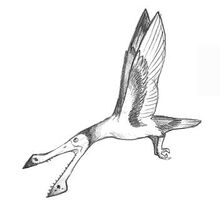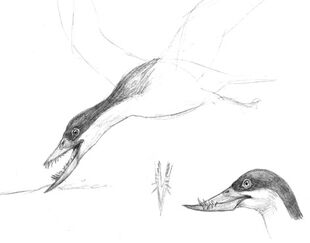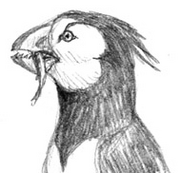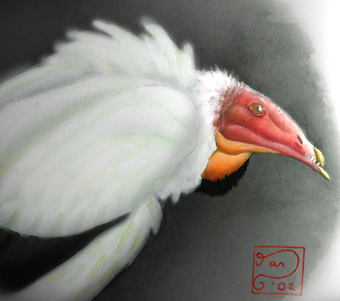HISTORY[]
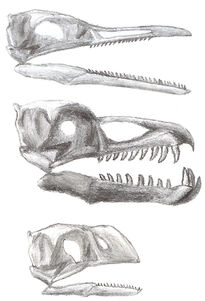
Ichthyornithiform skulls. Top to bottom: Ichthyornis (Extinct), Harpiavis aeneas (Aeneus harpy), Odontacala compsognatha (Common toothauk).
Ichthyornithiformes, a large group birds including bay-gulls, surfbirds, and harpies, is a clade with a very long lineage. Ichthies little different from today's bay-gulls were common as far back as the Cretaceous, represented by such famous genera as Ichthyornis. Although a few clades have diverged from this root (a few are spectacularly weird), many have changed little since the Mesozoic.
Ichthyornithiforms can, however, be distinguished from gulls (true alcids) as soon as they open their beaks - the rear part of the upper beak and the entire lower beak are lined with conical teeth. The lower beak also possesses three joints - one at the tip, the other two at its rear ends some distance in front of the jaw joints - that allow ichthies' jaws to gape wide, allowing them to eat larger prey than other birds of similar size.
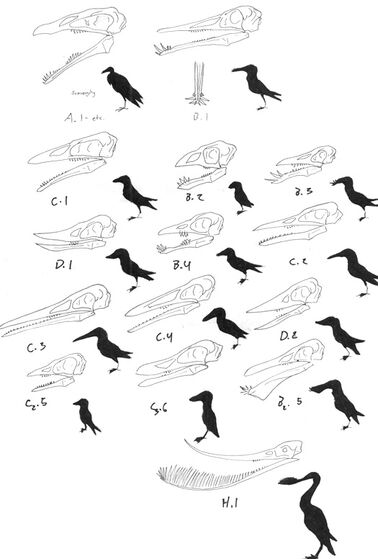
Spec's ichthies are a diverse group and have radiated out into many different niches since the Cretaceous.
NEOICHTHYORNITHIDAE (Bay-gulls)[]
Though its Cretaceous representative genera are long dead, the very similar Neoichthyornithidae is still alive and well in Spec. Bay-gulls closely resemble their ancestors, and occupy most of the Northern Hemisphere's large seabird niches.
In Spec, no seaside habitat is complete without its contingent of screaming bay-gulls. These large piscivores are common the world over, and eat a variety of marine detritus, including fish, carrion, crustaceans, and the young of other seabirds. These generalists can even be found far inland, as long as the requisite piles of refuse are present to feed them.
LEVIGNATHIDAE (Surf-birds, wavesters, toothauks)[]
Levignaths form the largest and most wide-spread clade of ichthyornithiforms. Similar to classic ichthyornithids, surf-birds have headed toward a range of smaller-size niches. Their skeletons are quite lightly-built, run through with an extensive air-sack system, and their skulls have undergone even greater reduction. Levignaths' name-sake jaws are intensely pneumatisized (even more so than other ichthies) reduced to a mere scaffolding of bone over cartilage.
Most surf-birds are tern-like skimmers or fish-eating generalists (genera Aestavis and Larianus), but a few have explored auk and cormerant-like niches.
The waters of the north Atlantic, warmed as they are by the Gulf Stream, are rich and warm, filled with fishes and cephalopods that are food for many larger vertebrates. Sharks, selkies, and seaguins are, of course, quite common in these waters, but not all piscivores are swimmers. Every island of any size both here and in the Pacific off the coast of British Columbia is home to a bustling colony of little, rotund diving birds - toothauks.
Toothauks (Odontalca sp.)[]
Though toothauks (Odontalca sp.) look and behave a great deal like a Home-Earth puffin, this resemblance is pure convergence; the tooth-filled lower bill of toothauks belies its ichthyornithiform heritage. They are specialized predators of small fishes and cephalopods, which they catch by diving from the air and "swimming" in pursuit of their prey using their wings in a manner similar to the penguins of the Southern Hemisphere.
While toothauks are better fliers than penguins, their wings have been adapted to underwater flight and so they are, at best, mediocre aerialists. These fat little birds are often robbed in flight by their more nimble cousins and so travel in vast flocks to confuse predators and aerial pirates.
Siren (Odontalca scopulis)[]
The siren (Odontalca scopulis) is a toothauk that nests on rocky islands in the northern Pacific and engages in aggressive flocking behavior to drive away or kill any intruders - be they volant, terrestrial or aquatic - from the nesting colony. Sirens are known to feed on the flesh of the said intruders, though they generally feed on fish. Vocalizations of the species are said to eerily resemble singing and moaning of female humans.
HARPIAVIIDAE (Harpies)[]
As the Oligocene grasslands began to develop, huge herds of grazing dinosaurs swept across the plains. When dead, such animals form a considerable food resource in the dry steppes. As ichthies have always gladly taken carrion that was lying on the shore, one group of them has shifted inland and become the Northern Hemisphere's vulture analogues.
From a distance, harpies are almost indistinguishable from their RL counterparts. With wide black wings and small, naked heads, harpies have taken the body-type of carrion birds everywhere, but a closer look will reveal some clear distinctions between harpies and Home-Earth’s carthids.
Most of the obvious differences between a harpy and a vulture are to be found in the head. As ichthyorniforms, harpies possess teeth, which are generally serrated and angled sharply backwards, like the teeth of a predatory lizard. These teeth are most prominent on the outward-jutting lower jaw, where they form a cutting tool that slices flesh and tendons, allowing the birds to quickly hack apart and unwieldy carcass and carry it to safety in pieces.
Wakinyan (Tonitriavis stupfidens)[]
This giant harpy with a six-meter wingspan found throughout North America, from the western mountain ranges as far northeast as the Adirondacks and down south into Mexico and Florida. Weighting in at seventy-plus kilos, the wakinyan is an impressive scavenger, dominating all other harpies and corpse-robbing birds at carcasses. Even draks will give way to the flashing toothed beaks and powerful, smacking wings on occasion.
The adults have a black coat with shining bronzed gold wingtips and underfeathers. Breeding in high cliff caves and niches every other year, the young grow quickly into fledge-hood. Fledged offspring have an immature coat of speckled black and white until their 5th year, when the fully bald, red head and gold-trimmed black coat signals adulthood.
,=Neochyornithidae= Neoichthyornis atlanticus (Atlantic bay-gull )
,=|
| | ,=O. scopulis (Siren)
| `=Levignathidae=Odontacala=|
| `=O. pictus ( Painted toothauk)
Icthyorthiformes=|
| ,=H. aeneas (Aeneus harpy)
`=Harpiaviidae= Harpiavis=|
`=H. phineas (Phineus harpy )

